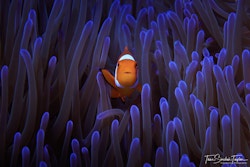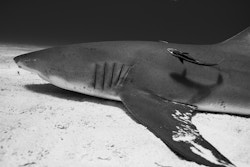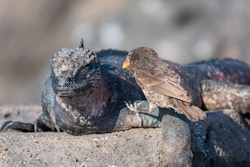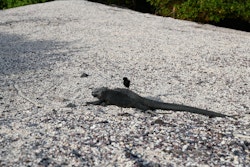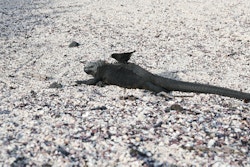Cooperation in nature: one for all and all for one
In nature, whether the collaboration is between members of the same species, or between individuals of different species, cooperation is a founding principle of diversity, complexity and resilience. Explanations with Katia Nicolet, PhD in marine biology, while in Galapagos islands !

Vulcano Sierra Negra, Galapagos
Our vessel is now in the Galapagos Archipelago, a group of volcanic islands 1,000 km off the South American continent, which rose out of water about 5 million years ago. All life, thus, had to colonise these new lands through seed dispersal by the wind or accidental arrival of animals by air or vegetation rafts. As a result, very few species survived the journey, involving multiple weeks at sea under the burning sun and without water or food.
Some animal groups, more tolerant to desiccation and food scarcity, are thus overrepresented on the islands, like reptiles, whereas some other groups, such as insects and amphibiens, are under-represented. You could expect, once having reached these new lands, that species belonging to the same animal groups, would fiercely compete for the new ressources. We observe quite the opposite. What if cooperation was at the foundation of life on these islands?
In Darwin’s footsteps
The Galapagos archipelago instantly brings to mind the legendary voyage of Charles Darwin, genius naturalist and co-discoverer of the theory of evolution by means of natural selection. Darwin visited the islands in 1835, during his circumnavigation with the Beagle. There he observed various species and realised many were very similar, and diverging only slightly more from their relatives in mainland Equator. The mockingbirds, especially, inspired Darwin as he was convinced the four species present on the islands had a very recent common ancestor.
We had the opportunity to meet Gustavo Jiménez, curator at the Charles Darwin Foundation on Santa Cruz.
Back to basics
But first, let’s go back to the fundamentals of Darwin’s theory of evolution. Evolution by natural selection, Darwin wrote, mainly depends on “success in leaving progeny”. This sentence was simplified as “the survival of the fittest”, with the fittest being the strongest and most competitive individual. Often however, individuals benefit from working with each other.
Cooperation, then, is sometimes the key.
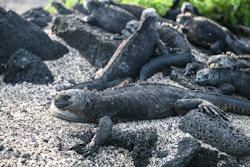
Iguanas in Muro de las Lagrimas
For a long time, cooperation was thought to be unsustainable, because cheaters would eventually take advantage of a cooperative individual until the relationship broke down. However, cooperation, truly, is everywhere: plants providing each other with nutrients, fish remove parasite from each other’s scales, ants build nests together, predators hunt in packs and bees will even give their own life for the benefit of the hive.
Whether the collaboration is between members of the same species, or between individuals of different species, cooperation is a founding principle of diversity and complexity in nature.
Trade rather than piracy
To circumvent the lack of pollinating insects, Galapagos plants co-evolved with birds to spread their gametes. From a single species of finch that colonized the islands about 2 million years ago, 13 species arose, each with a specific type of beak, specialized in the foraging of various food source : cactus seeds, plant nectar and harmful insects. The birds gain a food source, the plants a new pollinator, and together they slowly created the ecosystems that we see today.
Another example is the cooperation between the reptiles and birds. It is not uncommon in the Galapagos to see a finch hopping on an iguana or a giant tortoise, inspecting it up close and removing the dead cells and parasites on their skin. Again, each species finds a benefit in this interaction: the bird receives an easy meal, and the reptile is kept clean and health. In this exemple and the previous one, individuals of different species are dependent on each other, and the interactions are frequent, which allow cooperation based on reciprocity - trade rather than piracy.
Forever together
Throughout earth history, cooperation has changed the course of life’s evolution and permitted to reach more complex levels of organisation. An early and major example is the origin of multicellularity. Our cells are all descended from single-celled organisms that once went from competing with each other to working together to function as a cohesive unit. Similarly, mitochondria in eukaryotic cells and chloroplasts in plant cells are descended from free-living bacteria that gave up their autonomy for a cooperative existence.
When you think about it, our own life depends on the collaboration of million, billion, or even trillion of cells working together to form tissues and organs, but also the cooperation with thousands of bacteria that inhabit our skin and guts allowing us to digest the food we eat or combat external pathogens.
Everything we eat, drink, build or use comes from nature and depends on the specific property of other organisms. Plants, for example, can produce organic matter and emit oxygen through a process called photosynthesis. Without plants, we would not be able to breath or eat. We might not realize it, but we depend on the survival of billion of organisms, all of us embedded in the matrice of life.
Maybe it is time to observe nature in a different way, to change our gaze to not focus solely on the lion killing the antelope but observe also the finch on the tortoise back. Just like them, we have everything to gain by favoring cooperation over competition.
